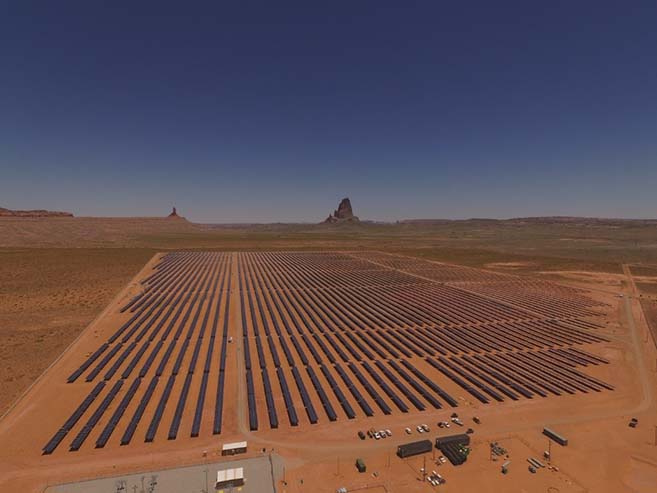
The Navajo Nation Kayenta Solar Program increased additional scholarship and internship opportunities for students in Navajo Chapters, and created a new energy workforce to increase job opportunities for Navajo.
Source: Credit to Navajo Tribal Utility Authority (NTUA)
| Location | Monument Valley, Arizona |
|---|---|
| Project Sponsor / Borrower | Navajo Tribal Utility Authority |
| Program Areas |
|
| Value Capture Techniques | Joint Development & Right-of-Way Use Agreements |
| Mode | Other: Solar Farms |
| Description | The Navajo Nation reservation, located in the Southwestern United States, is comprised of land mostly in Arizona and partially extending into New Mexico and Utah. The Navajo Nation covers about 27,000 square miles in the Southwestern United States with approximately 270 sunny days a year. Thus, the Navajo Nation has the potential to develop utility-scale solar photovoltaic (PV) energy for the Navajo people and export electricity to major cities to generate revenues. In partnering with the Salt River Project (SRP) non-profit utility in 2015, the Navajo Tribal Utility Authority (NTUA) built its first two-phase utility-scale solar plant near Monument Valley, Arizona. The NTUA created a for-profit taxable entity to use Federal solar investor tax credits and a two-year power purchase and renewable energy credit agreement with SRP to fund the Kayenta Solar Project. Construction of Phase 1 began in 2016 and was estimated to supply electricity to 18,000 homes for the Navajo Nation. NTUA contracted with Isolux Corsan to engineer, procure, and construct a 27.3 megawatt (MW) solar plant on 198 acres outside of Kayenta, Arizona. The contract included building the solar project and training approximately 200 Navajos in the high-level technical procedures required to assemble and install the plant's tracker and foundation system. Phase I generated over $3 million in taxes to the Navajo Nation and the first year's tax revenue exceeded $200,000. Over 30 years, the project is expected to generate nearly $7.6 million. At the height of construction, 85 percent of the nearly 300 people who worked on the project were of Navajo descent. The project also created long-term solar and maintenance jobs for Navajo people. Phase I paid $5.2 million in construction and generated $15.6 million in economic activity, which helped to pay for the electrification of Navajo homes. Phase II, which included the creation of 150 temporary jobs for Navajo people and generated $15.5 million in economic impact, was completed in 2019. During this phase, construction generated over $3 million in taxes to the Navajo Nation and the first year's tax revenue exceeded $200,000 with a 30-year total estimated at nearly $7.6 million. Phase II generated an additional 27.3 MW, totaling 56 MW over both phases—enough to power 36,000 homes. The electricity from this solar farm will stay in the Navajo Nation, and the revenue generated will help fund the Light Up Navajo initiative that brings power to families previously without electricity. Based on project success in offering electricity to 233 families, NTUA created a new goal of connecting 300 families to the power grid. To help do so, NTUA and the SRP signed a long-term solar confirmation targeted at developing at least 500 MW of renewable energy projects over the next 5–10 years. |
| Cost | Phase I
Phase II
|
| Funding Sources | Rural Utility Service amortization |
| Project Delivery / Contract Method | Design-build; Engineering, Procurement and Construction (EPC) Contract |
| Private Partner | Rural Utility Service |
| Project Advisors / Consultants |
|
| Lenders | Rural Utility Service |
| Duration / Status | NTUA announced on December 16, 2015 it would work with the Salt River Project (SRP), a community-based nonprofit utility serving the Phoenix area, to develop the utility-scale Kayenta Solar Project. On September 20, 2019, NTUA, SRP, and Navajo Nation leaders officially opened Phase II of the Kayenta Solar Project. |
| Financial Status / Financial Performance | The NTUA used a financing model that created a for-profit taxable entity to use the Federal solar investor tax credits and a two-year power purchase and renewable energy credit agreement with SRP, covering the loan repayments for the plant's construction. |
| Innovations |
|
| Related Links / Articles |
|
| Contacts | Glenn Steiger |